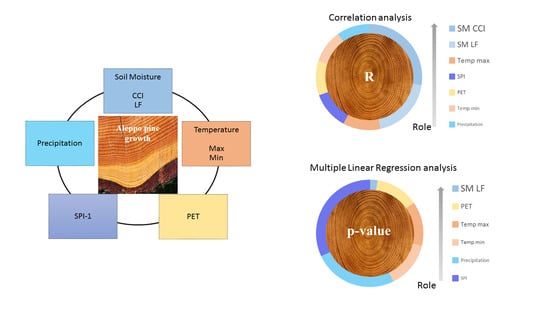Influence of Soil Moisture vs. Climatic Factors in Pinus Halepensis Growth Variability in Spain: A Study with Remote Sensing and Modeled Data
Abstract
:1. Introduction
2. Dataset and Study Area
2.1. Tree Samples and Study Area
2.2. Soil Moisture
2.3. Precipitation and Temperature
2.4. Standardized Precipitation Index (SPI)
2.5. Potential Evapotranspiration
3. Methods
3.1. Correlation Analysis
3.2. Multiple Linear Regression Analysis
4. Results
4.1. Analysis of the Influence of Soil Moisture and Climatic Factors
4.2. Combined Influence of Soil Moisture Together with Climatic Factors
4.3. Environmental Modulation of the Role of Soil Moisture in Aleppo Pine Growth
5. Conclusions
Author Contributions
Funding
Institutional Review Board Statement
Informed Consent Statement
Acknowledgments
Conflicts of Interest
References
- Lindner, M.; Maroschek, M.; Netherer, S.; Kremer, A.; Barbati, A.; García-Gonzalo, J.; Seidl, R.; Delzon, S.; Corona, P.; Kolström, M.; et al. Climate change impacts, adaptive capacity, and vulnerability of European forest ecosystems. For. Ecol. Manag. 2010, 259, 698–709. [Google Scholar] [CrossRef]
- Bonan, G.B. Forests and Climate Change: Forcings, Feedbacks, and the Climate Benefits of Forests. Science 2008, 320, 1444–1449. [Google Scholar] [CrossRef] [Green Version]
- He, T.; Shao, Q.; Cao, W.; Huang, L.; Liu, L. Satellite-Observed Energy Budget Change of Deforestation in Northeastern China and its Climate Implications. Remote Sens. 2015, 7, 11586–11601. [Google Scholar] [CrossRef] [Green Version]
- van der Werf, G.R.; Morton, D.C.; DeFries, R.S.; Olivier, J.G.J.; Kasibhatla, P.S.; Jackson, R.B.; Collatz, G.J.; Randerson, J.T. CO2 emissions from forest loss. Nat. Geosci. 2009, 2, 737–738. [Google Scholar] [CrossRef]
- Mankin, J.S.; Seager, R.; Smerdon, J.E.; Cook, B.I.; Williams, A.P. Mid-latitude freshwater availability reduced by projected vegetation responses to climate change. Nat. Geosci. 2019, 12, 983–988. [Google Scholar] [CrossRef]
- Bjorkman, A.D.; Myers-Smith, I.H.; Elmendorf, S.C.; Normand, S.; Rüger, N.; Beck, P.S.A.; Blach-Overgaard, A.; Blok, D.; Cornelisses, J.H.C.; Forbes, B.C.; et al. Plant functional trait change across a warming tundra biome. Nature 2018, 562, 57–62. [Google Scholar] [CrossRef]
- Vidal-Macua, J.J.; Ninyerola, M.; Zabala, A.; Domingo-Marimón, C.; Pons, X. Factors affecting forest dynamics in the Iberian Pen-insula from 1987 to 2012. The role of topography and drought. For. Ecol. Manag. 2017, 406, 290–306. [Google Scholar] [CrossRef]
- Kellomäki, S.; Väisänen, H. Modelling the dynamics of the forest ecosystem for climate change studies in the boreal conditions. Ecol. Modell. 1997, 97, 121–140. [Google Scholar] [CrossRef]
- Walther, G.R.; Post, E.; Convey, P.; Menzel, A.; Parmesan, C.; Beebee, T.J.; Fromentin, J.M.; Hoegh-Guldberg, O.; Bairlein, F. Eco-logical responses to recent climate change. Nature 2002, 416, 389–395. [Google Scholar] [CrossRef]
- Frey, S.J.K.; Hadley, A.S.; Johnson, S.L.; Schulze, M.; Jones, J.A.; Betts, M.G. Spatial models reveal the microclimatic buffering ca-pacity of old-growth forests. Sci. Adv. 2016, 2, e1501392. [Google Scholar] [CrossRef] [Green Version]
- Caminero, L.; Génova, M.; Camarero, J.J.; Sánchez-Salguero, R. Growth responses to climate and drought at the southernmost European limit of Mediterranean Pinus pinaster forests. Dendrochronologia 2018, 48, 20–29. [Google Scholar] [CrossRef]
- Valladares, F.; Benavides, R.; Rabasa, S.G.; Díaz, M.; Pausas, J.G.; Paula, S.; Simonson, W.D. Global change and Mediterranean forests: Current impacts and potential responses. In Forests and Global Change; Coomes, D.A., Burslem, D.F.R.P., Simonson, W.D., Eds.; Cambridge University Press: Cambridge, UK, 2014; pp. 47–75. [Google Scholar]
- Barbéro, M.; Loisel, R.; Quezel, P.; Richardson, D.M.; Romane, F. Pines of the mediterranean basin. In Ecology and Biogeography of Pinus; Richardson, D.M., Ed.; Cambridge University Press: Cambridge, UK, 1998; pp. 153–170. [Google Scholar]
- Quézel, P. Taxonomy and biogeography of Mediterranean pines (Pinus halepensis and P. brutia). In Ecology, Biogeography and Management of Pinus halepensis and P. brutia Forest Ecosystems in the Mediterranean Basin; Neeman, G., Trabaud, L., Eds.; Backhuys Publishers: Leiden, The Netherlands, 2000; pp. 1–12. [Google Scholar] [CrossRef]
- de Luis, M.; Čufar, K.; di Filippo, A.; Novak, K.; Papadopoulos, A.; Piovesan, G.; Rathgeber, C.B.K.; Raventós, J.; Saz, M.A.; Smith, K.T. Plasticity in dendroclimatic response across the distribution range of Aleppo pine (Pinus halepensis). PLoS ONE 2013, 8, e83550. [Google Scholar] [CrossRef] [Green Version]
- Tejedor, E.; Serrano-Notivoli, R.; Saz, M.A.; Longares, L.A.; Novak, K.; Cuadrat, J.M.; de Luis, M. Rain in the desert; A precipitation reconstruction of the last 156 years inferred from Aleppo Pine in the Bardenas Natural Park, Spain. Dendrochronologia 2020, 62, 125759. [Google Scholar] [CrossRef]
- Gazol, A.; Ribas, M.; Gutiérrez, E.; Camarero, J.J. Aleppo pine forests from across Spain show drought-induced growth decline and partial recovery. Agric. For. Meteorol. 2017, 232, 186–194. [Google Scholar] [CrossRef]
- Mauri, A.; Di Leo, M.; de Rigo, D.; Caudullo, G. Pinus halepensis and Pinus brutia in Europe: Distribution, habitat, usage and threats. In European Atlas of Forest Tree Species; San-Miguel-Ayanz, J., de Rigo, D., Caudullo, G., Houston Durrant, T., Mauri, A., Eds.; Publications Office of the European Union: Luxembourg, 2016; p. e0166b8+. [Google Scholar]
- Nicault, A. Analyse de l’influence du Climat sur les Variations Inter et Intraannuelles de la Croissance Radiale du pin d’Alep (Pinus halepensis Mill.) en Provence Calcaire. Ph.D. Thesis, Sci. Univ. Aix-Marseille III, Marseille, France, 1999; p. 254. [Google Scholar]
- Novak, K.; de Luis, M.; Saz, M.A.; Longares, L.A.; Serrano-Notivoli, R.; Raventós, J.; Čufar, K.; Gričar, J.; Di Filippo, A.; Piovesan, G.; et al. Missing rings in Pinus halepensis—The missing link to relate the tree-ring record to extreme climatic events. Front. Plant Sci. 2016, 7, 727. [Google Scholar] [CrossRef]
- Vennetier, M.; Ripert, C.; Rathgeber, C. Autecology and growth of Aleppo pine (Pinus halepensis Mill.): A comprehensive study in France. For. Ecol. Manag. 2018, 413, 32–47. [Google Scholar] [CrossRef]
- Attolini, M.R.; Calvani, F.; Galli, M.; Nanni, T.; Ruggiero, L.; Schaer, E.; Zuanni, F. The relationship between climatic variables and wood structure in Pinus halepensis Mill. Theor. Appl. Climatol. 1990, 41, 121–127. [Google Scholar] [CrossRef]
- Nicault, A.; Rathgeber, C.; Tessier, L.; Thomas, A. Observations sur la mise en place du cerne chez le pin d’Alep (Pinus halepensis Mill.): Confrontation entre les mesures de croissance radiale, de densité et les facteurs climatiques. Ann. For. Sci. 2001, 58, 769–784. [Google Scholar] [CrossRef] [Green Version]
- Matamoros, M.R.; Merino, E.G.; Ibáñez, N.I.; Bernal, E.M. Sensibilidad y grado de adaptación de Pinus halepensis Mill. a la varia-bilidad climática en la provincia de Zaragoza. Cuadernos de la Sociedad Española de Ciencias Forestales 2008, 26, 137–142. [Google Scholar]
- de Luis, M.; Novak, K.; Raventós, J.; Gričar, J.; Prislan, P.; Čufar, K. Climate factors promoting intra-annual density fluctuations in Aleppo pine (Pinus halepensis) from semiarid sites. Dendrochronologia 2011, 29, 163–169. [Google Scholar] [CrossRef]
- Novak, K.; de Luis, M.; Raventós, J.; Čufar, K. Climatic signals in tree-ring widths and wood structure of Pinus halepensis in con-trasted environmental conditions. Trees 2013, 27, 927–936. [Google Scholar] [CrossRef]
- Hillel, D. Environmental Soil Physics: Fundamentals, Applications, and Environmental Considerations; Academic Press: London, UK, 1998. [Google Scholar]
- Oberhuber, W.; Kofler, W. Topographic influences on radial growth of Scots pine (Pinus sylvestris L.) at small spatial scales. Plant Ecol. 2000, 46, 231–240. [Google Scholar]
- Kramer, P. Soil Moisture in Relation to Plant Growth. Bot. Rev. 1944, 10, 525–559. [Google Scholar] [CrossRef]
- Seghieri, J.; Vescovo, A.; Padel, K.; Soubie, R.; Arjounin, M.; Boulain, N.; de Rosnay, P.; Galle, S.; Gosset, M.; Mouctar, A.H.; et al. Relationships between climate, soil moisture and phenology of the woody cover in two sites located along the West African latitudinal gradient. J. Hydrol. 2009, 375, 78–89. [Google Scholar] [CrossRef]
- Manrique-Alba, A.; Ruiz-Yanetti, S.; Moutahir, H.; Novak, K.; de Luis, M.; Bellot, J. Soil moisture and its role in growth-climate relationships across an aridity gradient in semiarid Pinus halepensis forests. Sci. Total Environ. 2017, 574, 982–990. [Google Scholar] [CrossRef]
- Wei, L.; Zhou, H.; Link, T.E.; Kavanag, K.L.; Hubbart, J.A.; Du, E.; Hudak, A.T.; Marshall, J.D. Forest productivity varies with soil moisture more than temperature in a small montane watershed. Agric. For. Meteorol. 2018, 259, 211–221. [Google Scholar] [CrossRef]
- Samaniego, L.; Thober, S.; Kumar, R.; Wanders, N.; Rakovec, O.; Pan, M.; Zink, M.; Sheffield, J.; Wood, E.F.; Marx, A. Anthropogenic warming exacerbates European soil moisture droughts. Nat. Clim. Chang. 2018, 8, 421–426. [Google Scholar] [CrossRef]
- Bartalis, Z.; Wagner, W.; Naeimi, V.; Hasenauer, S.; Scipal, K.; Bonekamp, H.; Figa, J.; Anderson, C. Initial soil moisture retrievals from the METOP-A Advanced Scatterometer (ASCAT). Geophys. Res. Lett. 2007, 34, L20401. [Google Scholar] [CrossRef] [Green Version]
- Kerr, Y.; Waldteufel, P.; Wigneron, J.-P.; Delwart, S.; Cabot, F.; Boutin, J.; Escorihuela, M.J.; Font, J.; Reul, N.; Gruhier, C.; et al. The SMOS mission: New tool for monitoring key elements of the global water cycle. Proc. IEEE 2010, 98, 666–687. [Google Scholar] [CrossRef] [Green Version]
- Chan, S.; Bindlish, R.; O’Neill, P.; Njoku, E.; Jackson, T.; Colliander, A.; Chen, F.; Burgin, M.; Dunbar, S.; Piepmeier, J.; et al. Assessment of the SMAP Passive Soil Moisture Product. IEEE Trans. Geosci. Remote Sens. 2016, 54, 4994–5007. [Google Scholar] [CrossRef]
- Dorigo, W.; Wagner, W.; Albergel, C.; Albrecht, F.; Balsamo, G.; Brocca, L.; Chung, D.; Ertl, M.; Forkel, M.; Gruber, A.; et al. ESA CCI Soil Moisture for improved Earth system understanding: State-of-the art and future directions. Remote Sens. Environ. 2017, 203, 185–215. [Google Scholar] [CrossRef]
- Kerr, Y.; Wigneron, J.-P.; Al Bitar, A.; Mialon, A.; Srivastava, P.K. Soil Moisture from Space: Techniques and Limitations. In Satellite Soil Moisture Retrieval: Techniques and Applications; Srivastava, P.K., Petropoulos, G., Kerr, Y., Eds.; Elsevier: Amsterdam, The Netherlands, 2016; pp. 3–27. [Google Scholar]
- Vittucci, C.; Ferrazzoli, P.; Kerr, Y.; Richaume, P.; Guerriero, L.; Rahmoune, R.; Vaglio Laurin, G. SMOS retrieval over forests: Ex-ploitation of optical depth and tests of soil moisture estimates. Remote Sens. Environ. 2016, 180, 115–127. [Google Scholar] [CrossRef] [Green Version]
- Colliander, A.; Cosh, M.H.; Kelly, V.R.; Kraatz, S.; Bourgeau-Chavez, L.; Siqueira, P.; Roy, A.; Konings, A.G.; Holtzman, N.; Misra, S.; et al. SMAP detects soil moisture under temperate forest canopies. Geophys. Res. Lett. 2020, 47. [Google Scholar] [CrossRef]
- Kim, H.; Wigneron, J.-P.; Kumar, S.; Dong, J.; Wagner, W.; Cosh, M.H.; Bosch, D.D.; Holifield Collins, C.; Starks, P.J.; Seyfried, M.; et al. Global scale error assessments of soil moisture estimates from microwave based active and passive satellites and land surface models over forest and mixed irrigated/dryland agriculture regions. Remote Sens. Environ. 2020, 251, 112052. [Google Scholar] [CrossRef]
- González-Zamora, A.; Sánchez, N.; Pablos, M.; Martínez-Fernández, J. CCI soil moisture assessment with SMOS soil moisture and in situ data under different environmental conditions and spatial scales in Spain. Remote Sens. Environ. 2019, 225, 469–482. [Google Scholar] [CrossRef]
- Kong, X.; Dorling, S.; Smith, R. Soil moisture modelling and validation at an agricultural site in Norfolk using the Met Office surface exchange scheme (MOSES). Meteorol. Appl. 2011, 18, 18–27. [Google Scholar] [CrossRef]
- Hagan, D.F.T.; Parinussa, R.M.; Wang, G.; Draper, C.S. An Evaluation of Soil Moisture Anomalies from Global Model-Based Datasets over the People’s Republic of China. Water 2020, 12, 117. [Google Scholar] [CrossRef] [Green Version]
- Martens, B.; Miralles, D.G.; Lievens, H.; van der Schalie, R.; de Jeu, R.A.M.; Fernández-Prieto, D.; Beck, H.E.; Dorigo, W.A.; Verhoest, N.E.C. GLEAM v3: Satellite-based land evaporation and root-zone soil moisture. Geosci. Model Dev. 2017, 10, 1903–1925. [Google Scholar] [CrossRef] [Green Version]
- Naz, B.S.; Kollet, S.; Franssen, H.J.H.; Montzka, C.; Kurtz, W. A 3 km spatially and temporally consistent European daily soil moisture reanalysis from 2000 to 2015. Sci. Data 2020, 7, 111. [Google Scholar] [CrossRef] [Green Version]
- Thielen, J.; Bartholmes, J.; Ramos, M.H.; de Roo, A. The European Flood Alert System-Part 1: Concept and development. Hydrol. Earth Syst. Sci. 2009, 13, 125–140. [Google Scholar] [CrossRef] [Green Version]
- Martínez-Fernández, J.; Almendra-Martín, L.; de Luis, M.; González-Zamora, A.; Herrero-Jiménez, C. Tracking tree growth through satellite soil moisture monitoring: A case study of Pinus halepensis in Spain. Remote Sens. Environ. 2019, 235, 111422. [Google Scholar] [CrossRef]
- Cook, E.; Holmes, R. Users manual for Arstan program. Adapted from users manual for program ARSTAN. In Tree-ring Chronologies of Western North America: California, Eastern Oregon and Northern Great Basin; Holmes, R., Adams, R.K., Fritts, H.C., Eds.; La-boratory of Tree-Ring Research, University of Arizona: Tucson, AZ, USA, 1986; pp. 50–65. [Google Scholar]
- Cook, E.; Peters, K. Calculating unbiased tree-ring indices for the study of climatic and environmental change. Holocene 1997, 7, 361–370. [Google Scholar] [CrossRef]
- Gruber, A.; Scanlon, T.; van der Schalie, R.; Wagner, W.; Dorigo, W. Evolution of the ESA CCI Soil Moisture climate data records and their underlying merging methodology. Earth Syst. Sci. Data 2019, 11, 717–739. [Google Scholar] [CrossRef] [Green Version]
- Dorigo, W.; Gruber, A.; de Jeu, R.A.M.; Wagner, W.; Stacke, T.; Loew, A.; Albergel, C.; Brocca, L.; Chung, D.; Parinussa, R.M.; et al. Evaluation of the ESA CCI soil moisture product using ground-based observations. Remote Sens. Environ. 2015, 162, 380–395. [Google Scholar] [CrossRef]
- Chung, D.; Dorigo, W.; de Jeu, R.A.M.; Kidd, R.; Wagner, W. Product Specification Document—ESA CCI Soil Moisture. Version 4.4. 2018. Available online: https://www.esa-soilmoisture-cci.org/sites/default/files/documents/public/CCI%20SM%20v04.7%20documentation/ESA_CCI_Soil_Moisture_Product_Specification_Document_(PSD)_v04.7.pdf (accessed on 22 December 2020).
- Albergel, C.; Rüdiger, C.; Carrer, D.; Calvet, J.C.; Fritz, N.; Naeimi, V.; Bartalis, Z.; Hasenauer, S. An evaluation of ASCAT surface soil moisture products with in-situ observations in Southwestern France. Hydrol. Earth Syst. Sci. 2009, 13, 115–124. [Google Scholar] [CrossRef] [Green Version]
- Reichle, R.H.; De Lannoy, G.J.; Liu, Q.; Ardizzone, J.V.; Colliander, A.; Conaty, A.; Crow, W.; Jackson, T.; Jones, L.A.; Kimball, J.S.; et al. Assessment of the SMAP level-4 surface and root-zone soil moisture product using in situ measurements. J. Hydrometeorol. 2017, 18, 2621–2645. [Google Scholar] [CrossRef]
- González-Zamora, A.; Sánchez, N.; Martínez-Fernández, J.; Wagner, W. Root-zone plant available water estimation using the SMOS-derived soil water index. Adv. Water Resour. 2016, 96, 339–353. [Google Scholar] [CrossRef]
- de Roo, A.P.J.; Wesseling, C.G.; van Deursen, W.P.A. Physically based river basin modelling within a GIS: The LISFLOOD model. Hydrol. Process 2000, 14, 1981–1992. [Google Scholar] [CrossRef]
- Laguardia, G.; Niemeyer, S. On the comparison between the LISFLOOD modelled and the ERS/SCAT derived soil moisture estimates. Hydrol. Earth Syst. Sci. 2008, 12, 1339–1351. [Google Scholar] [CrossRef] [Green Version]
- van der Knijff, J.M.; Younis, J.; de Roo, A.P.J. LISFLOOD: A GIS-based distributed model for river basin scale water balance and flood simulation. Int. J. Geogr. Inf. Sci. 2008, 24, 189–212. [Google Scholar] [CrossRef]
- Voltas, J.; Lucabaugh, D.; Chambel, M.R.; Ferrio, J.P. Intraspecific variation in the use of water sources by the circum-Mediterranean conifer Pinus halepensis. New Phytol. 2015, 208, 1031–1041. [Google Scholar] [CrossRef] [PubMed] [Green Version]
- Ciabatta, L.; Massari, C.; Brocca, L.; Gruber, A.; Reimer, C.; Hahn, S.; Paulik, C.; Dorigo, W.; Kidd, R.; Wagner, W. SM2RAIN-CCI: A new global long-term rainfall data set derived from ESA CCI soil moisture. Earth Syst. Sci. Data 2018, 10, 267. [Google Scholar] [CrossRef] [Green Version]
- Cuo, L.; Pagano, T.C.; Wang, Q.J. A review of quantitative precipitation forecasts and their use in short-to medium-range streamflow forecasting. J. Hydrometeorol. 2011, 12, 713–728. [Google Scholar] [CrossRef]
- Wanders, N.; Karssenberg, D.; de Roo, A.; de Jong, S.M.; Bierkens, M.F.P. The suitability of remotely sensed soil moisture for im-proving operational flood forecasting. Hydrol. Earth Syst. Sci. Dis. 2013, 10, 13783–13816. [Google Scholar]
- Zhang, L.; Liu, Y.; Ren, L.; Jiang, S.; Yang, X.; Yuan, F.; Wang, M.; Wei, L. Drought Monitoring and Evaluation by ESA CCI Soil Moisture Products Over the Yellow River Basin. IEEE J. Sel. Top. Appl. Earth Obs. Remote Sens. 2019, 12, 3376–3386. [Google Scholar] [CrossRef]
- Liu, Y.; El-Kassaby, Y.A. Evapotranspiration and favorable growing degree-days are key to tree height growth and ecosystem functioning: Meta-analyses of Pacific Northwest historical data. Sci. Rep. 2018, 8, 8228. [Google Scholar] [CrossRef] [Green Version]
- Zalloni, E.; de Luis, M.; Campelo, F.; Novak, K.; De Micco, V.; di Filippo, A.; Vieira, J.; Nabais, C.; Rozas, V.; Battipaglia, G. Climatic Signals from Intra-annual Density Fluctuation Frequency in Mediterranean Pines at a Regional Scale. Front. Plant Sci. 2016, 7, 579. [Google Scholar] [CrossRef] [PubMed] [Green Version]
- Novak, K.; Saz, M.A.; Čufar, K.; Raventós, J.; de Luis, M. Age, climate and intra-annual density fluctuations in Pinus halepensis in Spain. IAWA J. 2013, 34, 459–474. [Google Scholar] [CrossRef] [Green Version]
- Serrano-Notivoli, R.; Beguería, S.; Saz, M.Á.; Longares, L.A.; de Luis, M. SPREAD: A high-resolution daily gridded precipitation dataset for Spain–an extreme events frequency and intensity overview. Earth Syst. Sci. Data 2017, 9, 721–738. [Google Scholar] [CrossRef] [Green Version]
- Serrano-Notivoli, R.; Beguería, S.; de Luis, M. STEAD: A high-resolution daily gridded temperature dataset for Spain. Earth Syst. Sci. Data 2019, 11, 1171–1188. [Google Scholar] [CrossRef] [Green Version]
- Eekhout, J.P.; Hunink, J.E.; Terink, W.; de Vente, J. Why increased extreme precipitation under climate change negatively affects water security. Hydrol. Earth Syst. Sci. 2018, 22, 5935–5946. [Google Scholar] [CrossRef] [Green Version]
- Martínez del Castillo, E.; Tejedor, E.; Serrano-Notivoli, R.; Novak, K.; Saz, M.A.; Longares, L.A.; de Luis, M. Contrasting patterns of tree growth of mediterranean pine species in the Iberian Peninsula. Forests 2018, 9, 416. [Google Scholar] [CrossRef] [Green Version]
- Serrano-Notivoli, R.; Martín-Vide, J.; Saz, M.A.; Longares, L.A.; Beguería, S.; Sarricolea, P.; Meseguer-Ruiz, O.; de Luis, M. Spa-tio-temporal variability of daily precipitation concentration in Spain based on a high-resolution gridded data set. Int. J. Climatol. 2018, 38, e518–e530. [Google Scholar] [CrossRef] [Green Version]
- McKee, T.B.; Doesken, N.J.; Kleist, J. The relationship of drought frequency and duration to time scales. In Proceedings of the 8th Conference on Applied Climatology, Anaheim, CA, USA, 17–22 January 1993; Volume 17, pp. 179–183. [Google Scholar]
- Svoboda, M.; Hayes, M.; Wood, D. Standardized Precipitation Index User Guide; World Meteorological Organization (WMO): Geneva, Switzerland, 2012. [Google Scholar]
- Harris, I.; Osborn, T.J.; Jones, P.; Lister, D.H. Version 4 of the CRU TS monthly high-resolution gridded multivariate climate dataset. Sci. Data 2020, 7, 109. [Google Scholar] [CrossRef] [PubMed] [Green Version]
- Dikshit, A.; Pradhan, B.; Alamri, A.M. Short-Term Spatio-Temporal Drought Forecasting Using Random Forests Model at New South Wales, Australia. Appl. Sci. 2020, 10, 4254. [Google Scholar] [CrossRef]
- Haile, G.G.; Tang, Q.; Hosseini-Moghari, S.M.; Liu, X.; Gebremicael, T.G.; Leng, G.; Kebede, A.; Xu, X.; Yun, X. Projected impacts of climate change on drought patterns over East Africa. Earths Future 2020, 8, e1502. [Google Scholar] [CrossRef]
- Mubialiwo, A.; Onyutha, C.; Abebe, A. Historical Rainfall and Evapotranspiration Changes over Mpologoma Catchment in Uganda. Adv. Meteorol. 2020, 2020, 8870935. [Google Scholar] [CrossRef]
- Allen, R.G.; Pereira, L.S.; Raes, D.; Smith, M. Crop Evapotranspiration—Guidelines for Computing Crop Water Requirements; FAO Irrigation and Drainage Paper, 56; FAO: Rome, Italy, 1998. [Google Scholar]
- Harris, I.; Jones, P.D.; Osborn, T.J.; Lister, D.H. Updated high-resolution grids of monthly climatic observations-The CRU TS3.10 Dataset. Int. J. Climatol. 2014, 34, 623–642. [Google Scholar] [CrossRef] [Green Version]
- Paul, R.K. Multicollinearity: Causes, Effects and Remedies; IASRI: New Delhi, India, 2006; pp. 58–65.
- Montgomery, D.C.; Peckand, E.A.; Vining, G.G. Introduction to Linear Regression Analysis, 5th ed.; Wiley: New York, NY, USA, 2001. [Google Scholar]
- de Luis, M.; Gričar, J.; Čufar, K.; Raventós, J. Seasonal dynamics of wood formation in Pinus halepensis from dry and semi-arid ecosystems in Spain. IAWA J. 2007, 28, 389–404. [Google Scholar] [CrossRef] [Green Version]
- Olivar, J.; Bogino, S.; Spiecker, H.; Bravo, F. Climate impact on growth dynamic and intra-annual density fluctuations in Aleppo pine (Pinus halepensis) trees of different crown classes. Dendrochronologia 2012, 30, 35–47. [Google Scholar] [CrossRef]
- Olivar, J.; Bogino, S.; Spiecker, H. Changes in climate-growth relationships and IADF formation over time of pine species (Pinus halepensis, P. pinaster and P. sylvestris) in Mediterranean environments. For. Syst. 2015, 24, 10. [Google Scholar] [CrossRef] [Green Version]
- Campelo, F.; Nabais, C.; Freitas, H.; Gutiérrez, E. Climatic significance of tree-ring width and intra-annual density fluctuations in Pinus pinea from a dry Mediterranean area in Portugal. Ann. For. Sci. 2007, 64, 229–238. [Google Scholar] [CrossRef] [Green Version]
- Pasho, E.; Camarero, J.J.; Vicente-Serrano, S.M. Climatic impacts and drought control of radial growth and seasonal wood formation in Pinus halepensis. Trees 2012, 26, 1875–1886. [Google Scholar] [CrossRef]
- Papadopoulos, A.; Serre-Bachet, F.; Tessier, L. Tree ring to climate relationships of Aleppo pine (Pinus halepensis Mill.) in Greece. Ecol. Mediterr. 2001, 27, 89–98. [Google Scholar] [CrossRef]
- de Luis, M.; Novak, K.; Čufar, K.; Raventós, J. Size mediated climate–growth relationships in Pinus halepensis and Pinus pinea. Trees 2009, 23, 1065–1073. [Google Scholar] [CrossRef]
- Linares, J.C.; Delgado-Huertas, A.; Carreira, J.A. Climatic trends and different drought adaptive capacity and vulnerability in a mixed Abies pinsapo–Pinus halepensis forest. Clim. Chang. 2011, 105, 67–90. [Google Scholar] [CrossRef]
- Moreno-Gutiérrez, C.; Battipaglia, G.; Cherubini, P.; Saurer, M.; Nicolas, E.; Contreras, S.; Querejeta, J.I. Stand structure modulates the long-term vulnerability of Pinus halepensis to climatic drought in a semiarid Mediterranean ecosystem. Plant Cell Environ. 2012, 35, 1026–1039. [Google Scholar] [CrossRef]
- Sánchez-Salguero, R.; Navarro-Cerrillo, R.M.; Camarero, J.J.; Fernández-Cancio, Á. Selective drought-induced decline of pine spe-cies in southeastern Spain. Clim. Chang. 2012, 113, 767–785. [Google Scholar] [CrossRef]
- Sarris, D.; Christodoulakis, D.; Körner, C. Impact of recent climatic change on growth of low elevation eastern Mediterranean forest trees. Clim. Chang. 2011, 106, 203–223. [Google Scholar] [CrossRef]
- Camarero, J.J.; Olano, J.M.; Parras, A. Plastic bimodal xylogenesis in conifers from continental Mediterranean climates. New Phytol. 2010, 185, 471–480. [Google Scholar] [CrossRef] [PubMed]
- Lev-Yadun, S. Wood structure and the ecology of annual growth ring formation in Pinus halepensis and P. brutia. Ecology, bioge-ography and management of Pinus halepensis and P. brutia. In Forest Ecosystems in the Mediterranean Basin; Ne’eman, G.G., Trabaud, L., Eds.; Backhuys Publisher: Leiden, The Netherlands, 2000; pp. 67–78. [Google Scholar] [CrossRef]
- Cherubini, P.; Gartner, B.; Tognetti, R.; Bräker, O.U.; Schoch, W.; Innes, J. Identification, measurement and interpretation of tree rings in woody species from mediterranean climates. Biol. Rev. 2003, 78, 119–148. [Google Scholar] [CrossRef] [PubMed] [Green Version]
- de Luis, M.; Novak, K.; Raventós, J.; Gričar, J.; Prislan, P.; Čufar, K. Cambial activity, wood formation and sapling survival of Pinus halepensis exposed to different irrigation regimes. For. Ecol. Manag. 2011, 262, 1630–1638. [Google Scholar] [CrossRef]
- Camarero, J.J.; Manzanedo, R.D.; Sanchez-Salguero, R.; Navarro-Cerrillo, R.M. Growth response to climate and drought change along an aridity gradient in the southernmost Pinus nigra relict forests. Ann. For. Sci. 2013, 70, 769–780. [Google Scholar] [CrossRef]
- Casas-Gómez, P.; Sánchez-Salguero, R.; Ribera, P.; Linares, J.C. Contrasting Signals of the Westerly Index and North Atlantic Os-cillation over the Drought Sensitivity of Tree-Ring Chronologies from the Mediterranean Basin. Atmosphere 2020, 11, 644. [Google Scholar] [CrossRef]
- Helluy, M.; Prévosto, B.; Cailleret, M.; Fernandez, C.; Balandier, P. Competition and water stress indices as predictors of Pinus halepensis Mill. radial growth under drought. For. Ecol. Manag. 2020, 460, 117877. [Google Scholar] [CrossRef]
- Peña-Gallardo, M.; Vicente-Serrano, S.M.; Camarero, J.J.; Gazol, A.; Sánchez-Salguero, R.; Domínguez-Castro, F.; El Kenawy, A.; Beguería-Portugés, S.; Gutiérrez, E.; De Luis, M.; et al. Drought Sensitiveness on Forest Growth in Peninsular Spain and the Balearic Islands. Forests 2018, 9, 524. [Google Scholar] [CrossRef] [Green Version]
- Pasho, E.; Camarero, J.J.; de Luis, M.; Vicente-Serrano, S.M. Impacts of drought at different time scales on forest growth across a wide climatic gradient in north-eastern Spain. Agric. For. Meteorol. 2011, 151, 1800–1811. [Google Scholar] [CrossRef]
- Misson, L.; Rathgeber, C.; Guiot, J. Dendroecological analysis of climatic effects on Quercus petraea and Pinus halepensis radial growth using the process-based MAIDEN model. Can. J. For. Res. 2004, 34, 888–898. [Google Scholar] [CrossRef] [Green Version]
- Parsons, A.J.; Abrahams, A.D. Geomorphology of desert environments. In Geomorphology of Desert Environments; Abrahams, A.D., Parsons, A.J., Eds.; CRC Press: Boca Raton, FL, USA, 1994; pp. 3–12. [Google Scholar]
- Ziello, C.; Estrella, N.; Kostova, M.; Koch, E.; Menzel, A. Influence of altitude on phenology of selected plant species in the Alpine region (1971–2000). Clim. Res. 2009, 39, 227–234. [Google Scholar] [CrossRef] [Green Version]
- Coomes, D.A.; Allen, R.B. Effects of size, competition and altitude on tree growth. J. Ecol. 2007, 95, 1084–1097. [Google Scholar] [CrossRef]
- Paniagua, L.L.; García-Martín, A.; Moral, F.J.; Rebollo, F.J. Aridity in the Iberian Peninsula (1960–2017): Distribution, tendencies, and changes. Theor. Appl. Climatol. 2019, 138, 811–830. [Google Scholar] [CrossRef]
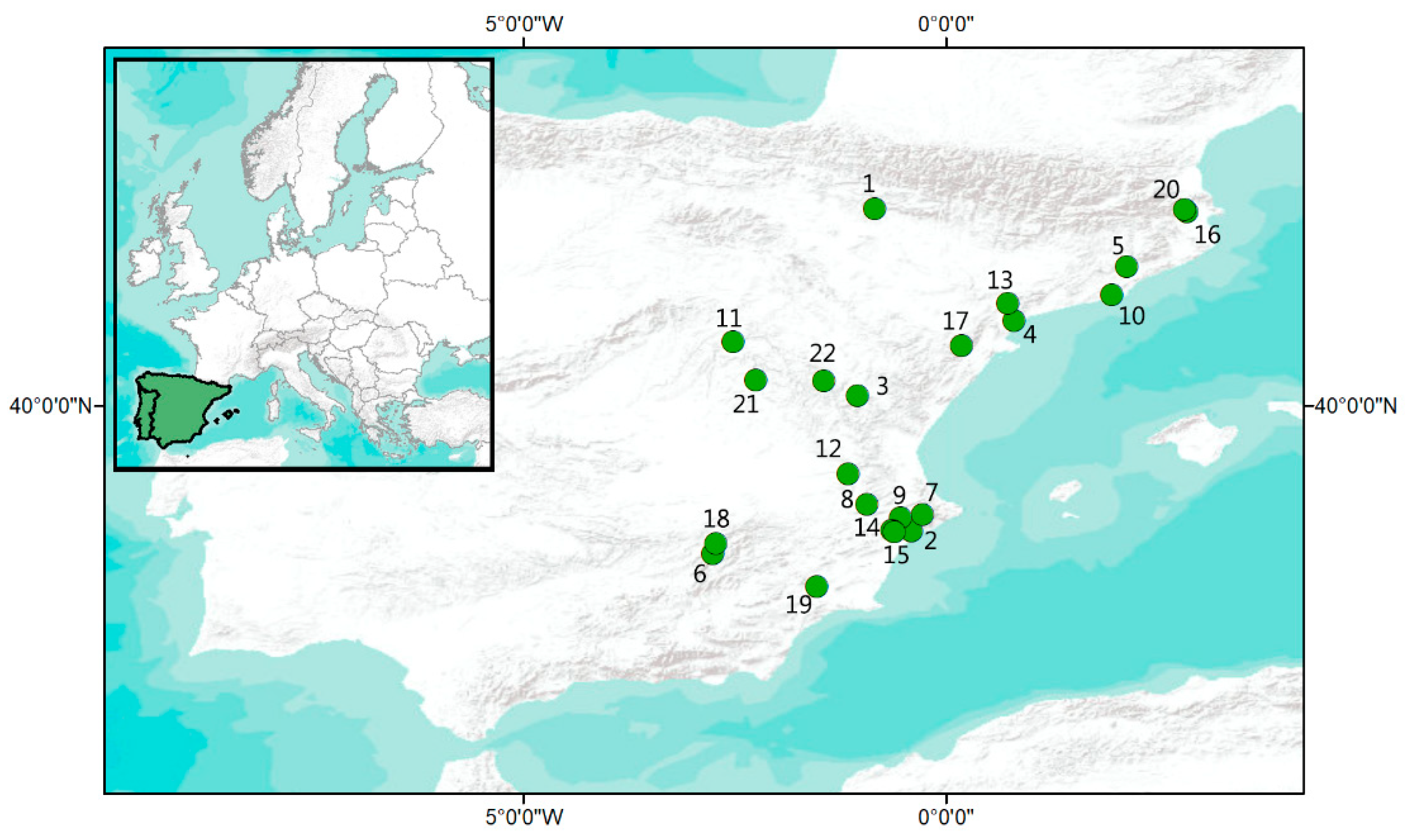
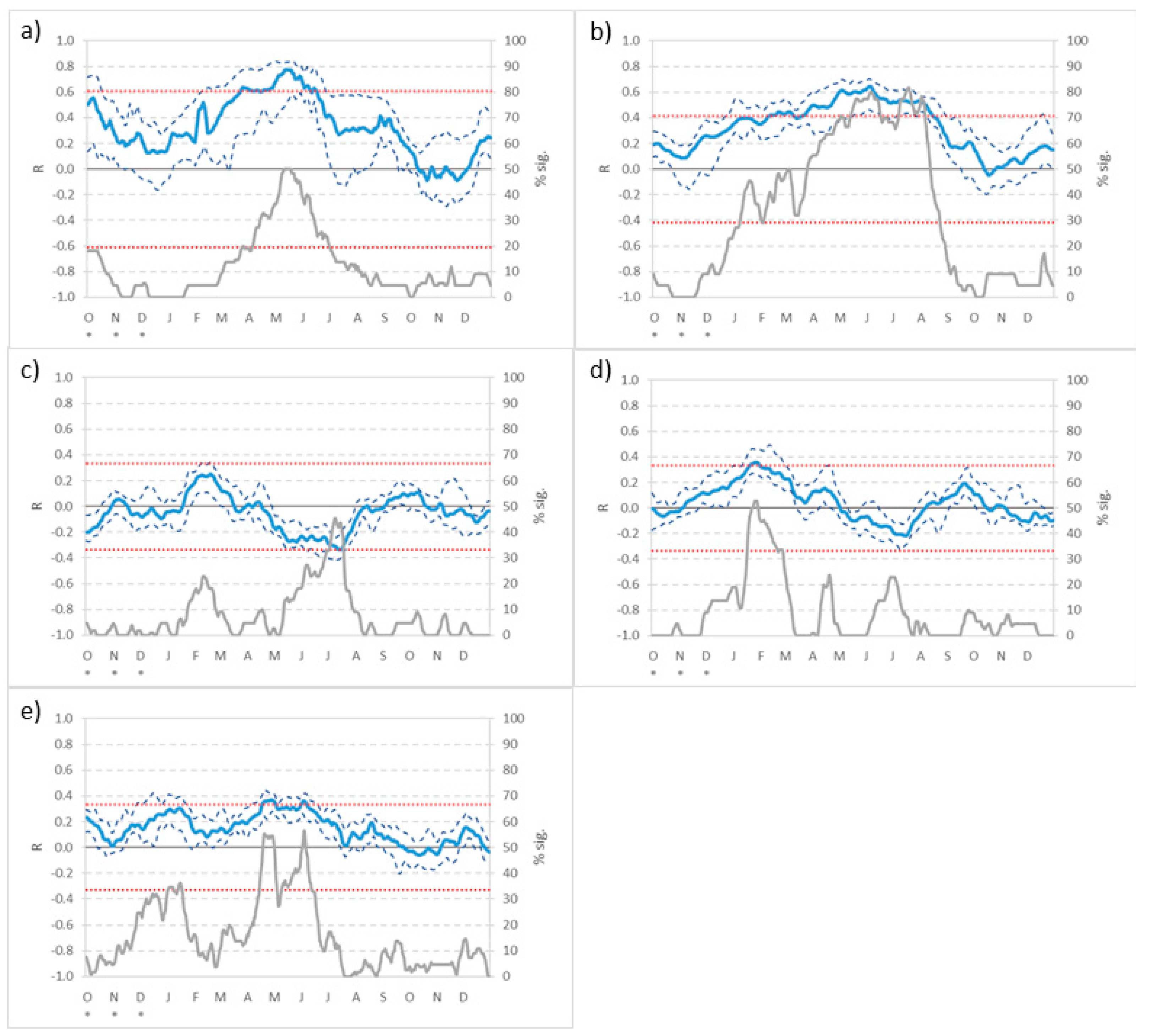


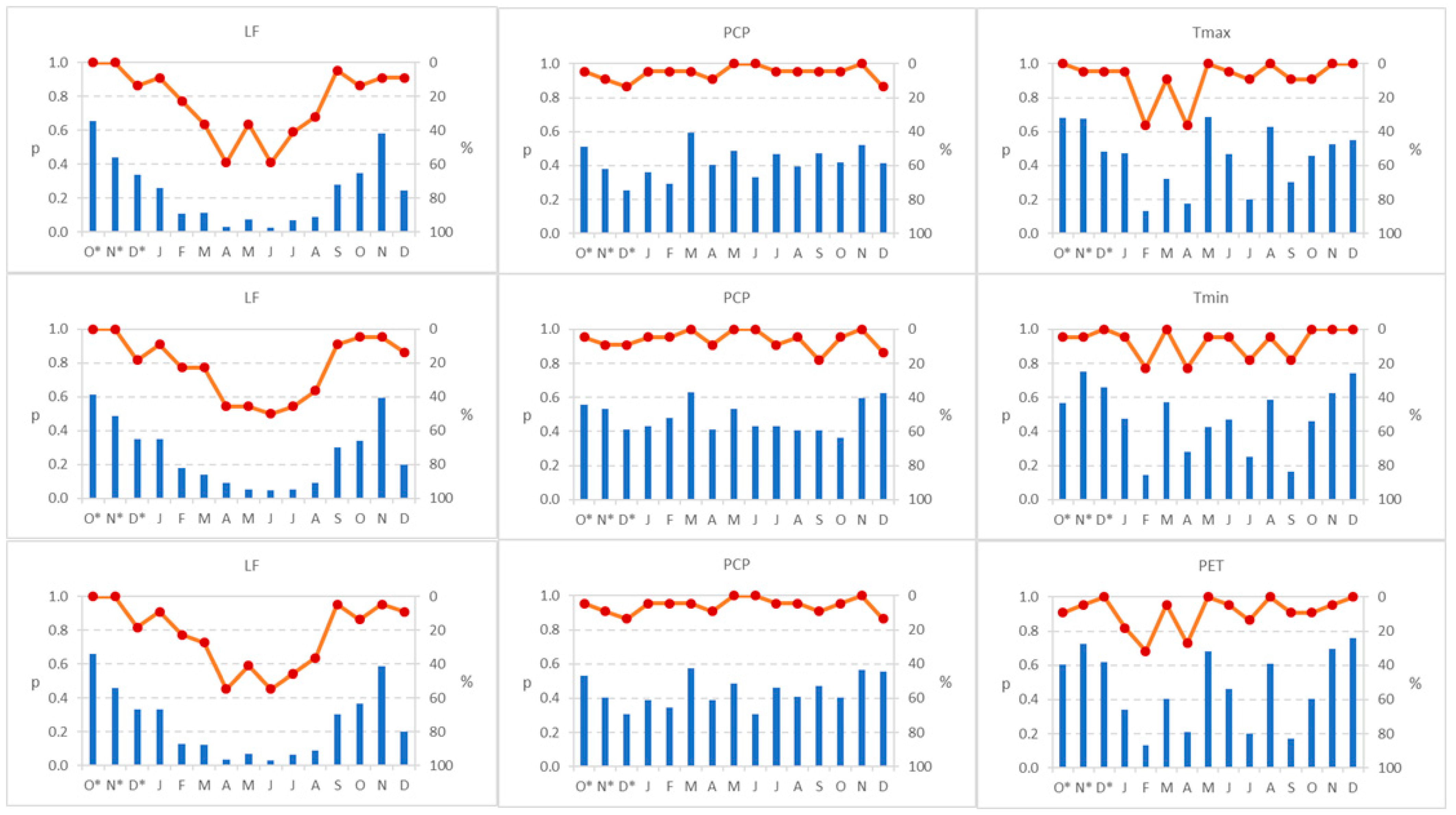
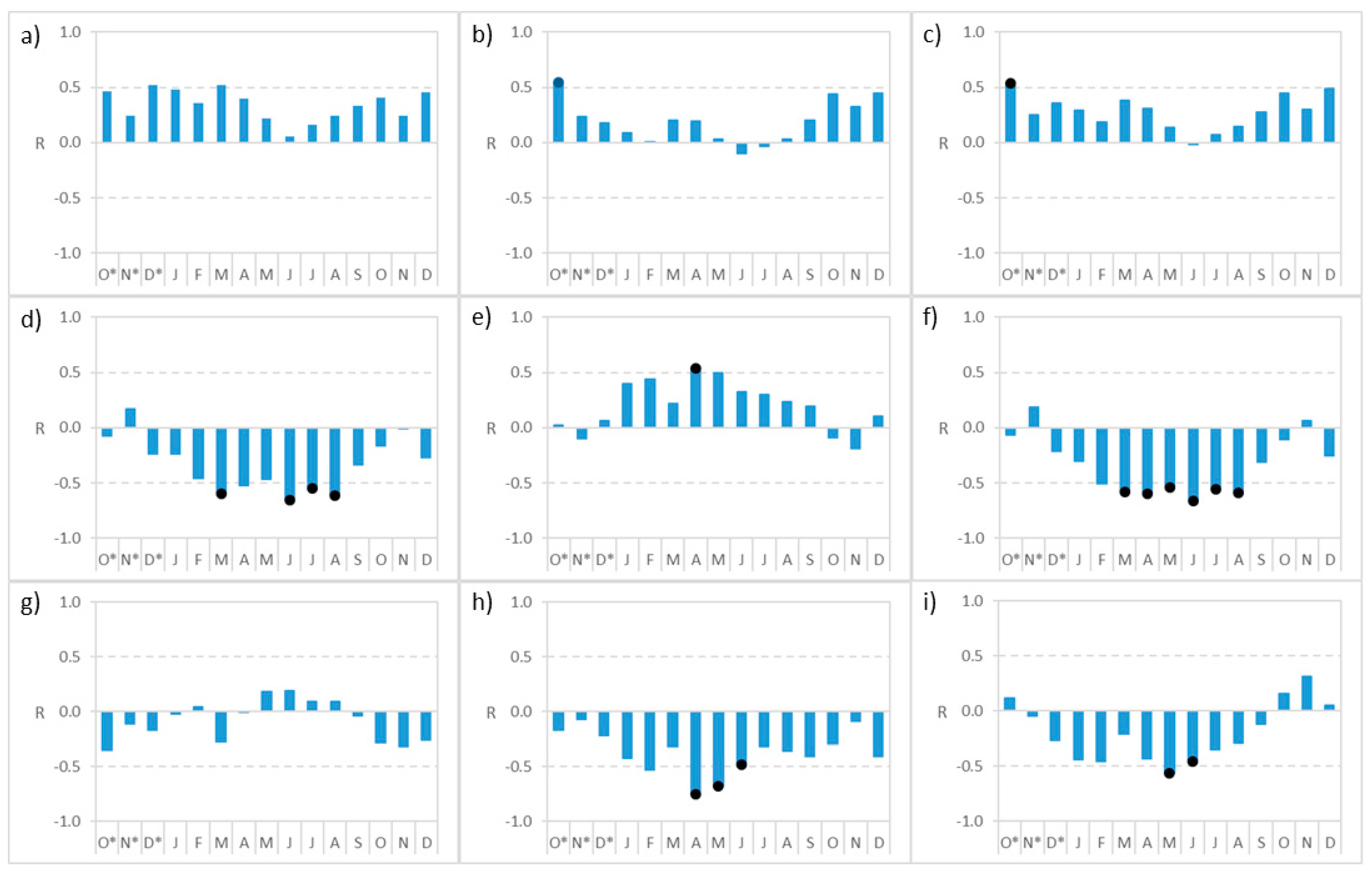
| Number | Sample | Site | Alt. (m) | MAP (mm) | MAT (°C) | PET (mm) | Lat. | Long. |
|---|---|---|---|---|---|---|---|---|
| 1 | SPAIN_AYE_PIHA_M | Ayerbe | 924 | 630 | 12.2 | 1102 | 42.32 | −0.84 |
| 2 | SPAIN_CAB_PIHA_M | Cabeco | 545 | 289 | 16.3 | 1163 | 38.51 | −0.40 |
| 3 | SPAIN_CAM_PIHA_M | Estación esquí Javalambre | 1676 | 600 | 9.0 | 1137 | 40.11 | −1.04 |
| 4 | SPAIN_CDG_PIHA_M | Sierra de Genessies | 525 | 808 | 14.8 | 1220 | 41.00 | 0.81 |
| 5 | SPAIN_CDM_PIHA_M | Caldes de Montbui | 340 | 588 | 15.3 | 1023 | 41.64 | 2.15 |
| 6 | SPAIN_CNC_PIHA_M | PN Cazorla—C. Nuevos | 960 | 636 | 13.6 | 1265 | 38.24 | −2.76 |
| 7 | SPAIN_CON_PIHA_M | Confrides | 1090 | 853 | 13.4 | 1163 | 38.70 | −0.28 |
| 8 | SPAIN_FHI_PIHA_M | Font de la Figuera | 680 | 359 | 14.8 | 1185 | 38.83 | −0.93 |
| 9 | SPAIN_FNT_PIHA_M | Alcoy | 1022 | 401 | 13.2 | 1185 | 38.67 | −0.54 |
| 10 | SPAIN_GAV_PIHA_M | Gava | 170 | 599 | 15.8 | 1108 | 41.31 | 1.97 |
| 11 | SPAIN_HUT_PIHA_M | Huetos | 995 | 523 | 12.0 | 1125 | 40.75 | −2.52 |
| 12 | SPAIN_JAL_PIHA_M | Jalance | 571 | 387 | 14.3 | 1193 | 39.19 | −1.15 |
| 13 | SPAIN_LAF_PIHA_M | La Figuera | 540 | 473 | 14.9 | 1206 | 41.21 | 0.73 |
| 14 | SPAIN_MAN_PIHA_M | Maigmo norte | 845 | 580 | 13.7 | 1185 | 38.52 | −0.64 |
| 15 | SPAIN_MAS_PIHA_M | Maigmo sur | 762 | 371 | 15.7 | 1223 | 38.50 | −0.60 |
| 16 | SPAIN_PDF_PIHA_M | Puig de les Forques | 185 | 747 | 14.5 | 1029 | 42.29 | 2.86 |
| 17 | SPAIN_PDP_PIHA_M | Pinar del Pla | 1280 | 582 | 13.0 | 1199 | 40.71 | 0.19 |
| 18 | SPAIN_PSC_PIHA_M | PN Cazorla-P. de Segura | 1030 | 679 | 15.0 | 1265 | 38.36 | −2.72 |
| 19 | SPAIN_SES_PIHA_M | Sierra Espuña | 846 | 387 | 15.1 | 1221 | 37.87 | −1.52 |
| 20 | SPAIN_SSJ_PIHA_M | Sierra de Sant Jordi | 235 | 747 | 14.5 | 1029 | 42.32 | 2.83 |
| 21 | SPAIN_TOR_PIHA_M | Torralba | 1095 | 521 | 12.1 | 1161 | 40.30 | −2.25 |
| 22 | SPAIN_VAC_PIHA_M | Valdecuenca | 1441 | 601 | 9.7 | 1137 | 40.29 | −1.45 |
Publisher’s Note: MDPI stays neutral with regard to jurisdictional claims in published maps and institutional affiliations. |
© 2021 by the authors. Licensee MDPI, Basel, Switzerland. This article is an open access article distributed under the terms and conditions of the Creative Commons Attribution (CC BY) license (http://creativecommons.org/licenses/by/4.0/).
Share and Cite
González-Zamora, Á.; Almendra-Martín, L.; de Luis, M.; Martínez-Fernández, J. Influence of Soil Moisture vs. Climatic Factors in Pinus Halepensis Growth Variability in Spain: A Study with Remote Sensing and Modeled Data. Remote Sens. 2021, 13, 757. https://doi.org/10.3390/rs13040757
González-Zamora Á, Almendra-Martín L, de Luis M, Martínez-Fernández J. Influence of Soil Moisture vs. Climatic Factors in Pinus Halepensis Growth Variability in Spain: A Study with Remote Sensing and Modeled Data. Remote Sensing. 2021; 13(4):757. https://doi.org/10.3390/rs13040757
Chicago/Turabian StyleGonzález-Zamora, Ángel, Laura Almendra-Martín, Martín de Luis, and José Martínez-Fernández. 2021. "Influence of Soil Moisture vs. Climatic Factors in Pinus Halepensis Growth Variability in Spain: A Study with Remote Sensing and Modeled Data" Remote Sensing 13, no. 4: 757. https://doi.org/10.3390/rs13040757





